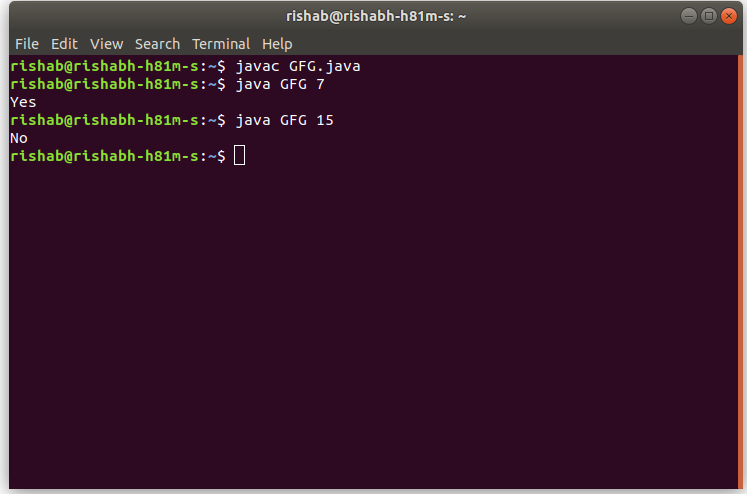Dado un número N, la tarea es verificar si N es un número primo o no usando argumentos de línea de comando .
Ejemplos:
Input: N = 7 Output: Yes Input: N = 15 Output: No
Acercarse:
- Dado que el número se ingresa como Argumento de línea de comando , no hay necesidad de una línea de entrada dedicada
- Extraiga el número de entrada del argumento de la línea de comando
- Este número extraído será de tipo String.
- Convierta este número en un tipo entero y guárdelo en una variable, digamos N
- Ahora recorra los números del 2 al N/2+1, usando una variable, digamos i.
En cada iteración,- Compruebe si divido N por completo (es decir, si es un factor de N).
- Si es así, entonces N no es un número primo.
- Si no, entonces N es un número primo.
- Una vez finalizado el bucle, se descubre si N es primo o no.
Nota: tenga en cuenta que 1 no está marcado en estos escenarios porque 1 no es ni primo ni compuesto.
Programa:
C
// C program to find
// the Prime Numbers from 1 to N
// using command line arguments
#include <stdio.h>
#include <stdlib.h> /* atoi */
// Function to check if x is prime
int isPrime(int x)
{
int i;
// Loop to check if x has any factor
// other than 1 and x itself
for (i = 2; i < x / 2 + 1; i++) {
if (x % i == 0) {
// Since i is a factor of x
// x is not prime
return 0;
}
}
// x is prime
return 1;
}
// Driver code
int main(int argc, char* argv[])
{
int n;
// Check if the length of args array is 1
if (argc == 1)
printf("No command line arguments found.\n");
else {
// Get the command line argument and
// Convert it from string type to integer type
// using function "atoi( argument)"
n = atoi(argv[1]);
// Check if n is prime
if (isPrime(n) == 1)
printf("Yes\n");
else
printf("No\n");
}
return 0;
}
Java
// Java program to reverse a string
// using command line arguments
class GFG {
// Function to check if x is prime
public static int isPrime(int x)
{
int i;
// Loop to check if x has any factor
// other than 1 and x itself
for (i = 2; i < x / 2 + 1; i++) {
if (x % i == 0) {
// Since i is a factor of x
// x is not prime
return 0;
}
}
// x is prime
return 1;
}
// Driver code
public static void main(String[] args)
{
// Check if length of args array is
// greater than 0
if (args.length > 0) {
// Get the command line argument and
// Convert it from string type to integer type
int n = Integer.parseInt(args[0]);
// Check if n is prime
if (isPrime(n) == 1)
System.out.println("Yes");
else
System.out.println("No");
}
else
System.out.println("No command line "
+ "arguments found.");
}
}
Producción:
- Cía:

- En Java:

Publicación traducida automáticamente
Artículo escrito por RishabhPrabhu y traducido por Barcelona Geeks. The original can be accessed here. Licence: CCBY-SA